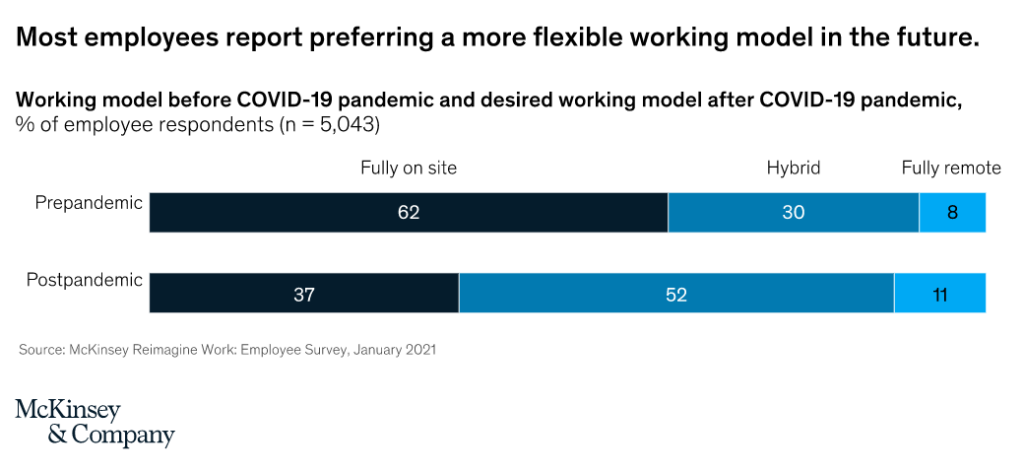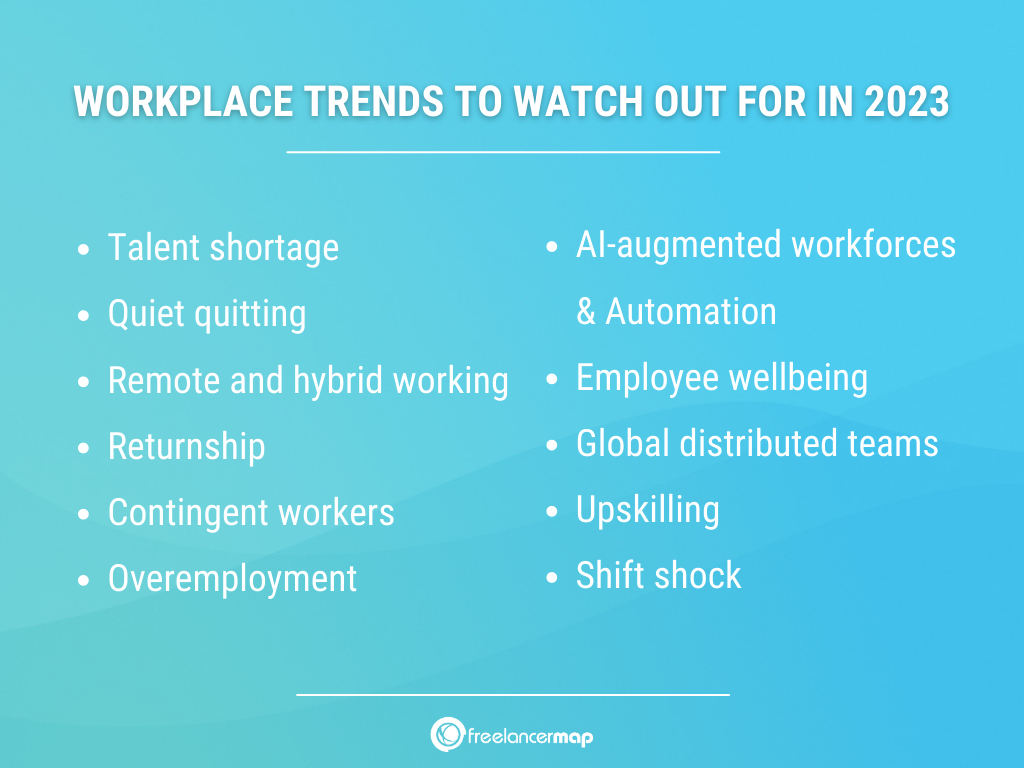With the pandemic bringing the world to a standstill, work schedules and routines were turned upside down in almost all industries around the globe. Many companies were forced to make drastic changes which resulted in the reshaping of work as we know it. This article explores trends surrounding the modern workplace and talks about the future of work and what to expect in 2023.
Workforce and Workplace Trends: What’s happening?
Below, we’ll explore some of the trends the workplace is experiencing right now and talk about how different concepts are acting as catalysts in reshaping work.
#1 Talent shortage
The shortage of skilled workers around the world is now one of the greatest challenges facing the industry, the skilled trades, commerce and the service sector.
In some sectors (like IT, care, or logistics), there is already a lack of suitable employees, leaving vacancies unfilled.
The lack of personnel is leading to a “war for talents”. It is therefore essential that companies actively approach qualified candidates instead of simply waiting for applications.
According to the Bitkom November 2022 report, only Germany is lacking 137,000 IT experts across all sectors. On average, a vacancy for IT professionals now remains unfilled for 7.1 months.
#2 Quiet quitting
Another trend that seems to have taken off is quiet quitting. This refers to the act of doing the absolute minimum in one’s role and putting no more time or effort than is necessary.
Quiet quitting first emerged in March of 2022 and has since gone viral across various workforce departments. According to Gallup, quiet quitters made up at least 50% of the U.S. workforce this year.
Gallup also found 18% of “loud quitters”, employees that are unhappy with their roles and spread their unhappiness.
Quiet quitting can be a big challenge for companies and it’s said to be a result of poor management. So, companies will need to tackle this by addressing manager engagement, promoting employee conversations, etc.
#3 Remote and Hybrid working
Next on the list is remote and hybrid working. After the pandemic, hybrid working is at an all-time high. This is mainly because, after remote working, many people now prefer working from home rather than commuting to the office.
A lot of companies around the world now offer their staff the opportunity to choose between the office and their home. And if companies fail to do so, employees will ultimately look elsewhere for opportunities that allow them this freedom.
In our most recent freelancer study, we asked freelancers from all over the globe about their preferred place and environment to work in. An overwhelming 63% of freelancers stated that they would prefer to work from home whereas 43% stated that a hybrid workplace would be the most ideal.
This applies to full-time employees, too. In a McKinsey & Company study, 52% of employees said they would like a Hybrid working model after the pandemic.


#4 Returnship
Returnship refers to a professional internship offered by companies to employees who have taken a long career break. Returnship is a good way to attract more talent to the workforce and because a lot of people are now entering the workforce (people dropped out of labour due to the pandemic), this concept has now begun trending again.
For example, Glassdoor currently has over 600 positions of returnship jobs on it. This proves that more and more companies are looking for talent and are willing to offer workers the chance to get back in the game.
Companies like Amazon are heavily promoting their returnship programs.


#5 Contingent workers
Next on the list of workplace trends is contingent workers. Contingent workers are professionals who work for companies without being hired as their employees.
These workers provide their services under either a contract or on an as-needed basis.
A few examples of contingent workers are:
- Freelancers
- Temporary workers
- Consultants
- Independent contractors etc.
More and more employers have now begun to outsource work to contingent workers, thus fueling the growth of the gig economy.
According to a report published by Mercer, the gig model is increasingly being favoured by companies with 6 in 10 executives embracing it. One of the biggest reasons for this is that companies all around the world are recognising the benefits offered by freelancers and contingent workers.
This is particularly true in the case of fractions CxOs.
Fractional CxO is someone who works in executive positions in companies and is able to divide their work between companies.
Fractional CxOs may work in any executive capacity such as product manager, director, COO, etc. Due to the shortage of talent in IT, Fractional CTOs are one of the most-demanded fractional profiles.
#6 Overemployment
With inflation making its way across the globe, more and more workers are taking on (extra) jobs to combat it. A large number of remote workers have begun to work multiple jobs, giving rise to the phenomenon now referred to as “overemployment”.
While there are some who view this as being unethical and wrong, the trend of overemployment essentially advocates for workers to exert control over their financial and professional lives.
A growing fraction of people are freelancing-on-the-side and are looking for financial stability and a greater career fulfilment with more meaningful work.
#7 AI-augmented workforces & Automation
The rise of technology in the past few decades has given birth to AI taking over certain human roles in the workplace. While this may sound like a bad thing, it doesn’t have to be. For example, more and more companies are now using AI to fill in roles that are not fit for human beings (think logging, mining, oil rig work etc.).
Not only does this improve the efficiency of the work in question, it also drastically improves safety and results in fewer accidents and even deaths.
Join our IT freelancer community today! Create your freelance profile in just 2 minutes.
#8 Employee well-being
Another important workplace trend that has been discussed at length recently is employee well-being. The well-being of employees does not only affect the workers in question, it is also vital to a business’s bottom line and its economic prosperity.
A positive employee experience is crucial to the success of any organisation and as such, needs to be a process that involves everyone in it.
To help improve the focus and productivity of employees and boost well-being, companies have now begun offering teams (both hybrid and remote) the right tools and approaches.
#9 Global distributed teams
Lots of organisations have taken to hiring employees from all around the globe. They rely on distributed teams to help them gain a competitive edge.
And while this concept of “digital workplace” isn’t particularly new, it has grown in popularity thanks to the spike in collaborative tools used by companies around the world.
For example, Loom facilitates asynchronous work amongst remote teams, Trello is great for project management, Miro is a nice whiteboard where teams can brainstorm and collaborate together, and the list goes on!
Companies need to work on creating a team feeling for the whole team and so company’s retreats are now often part of their activities.
#10 Upskilling
In an incredibly competitive job market, it helps to have an edge over fellow workers. Upskilling refers to the process of constantly learning new skills and using said skills to improve your career.
The process of upskilling is particularly important to temporary workers and freelancers. It can help them remain competitive, desirable, and productive, regardless of their specific industry and how many direct competitors they might have.
At the same time, it’s also important for full-time employees. Due to all the workforce trends, companies might benefit from upskilling and potentially job rotation programs.
#11 Shift shock
Shift shock refers to the shock new recruits experience once accepting a new role. According to a recent report, 72% of people stated that they instantly regretted a new job after starting it.
The main reason for this is because of expectations not being met by a company. Many workers go into new roles expecting certain things only to be left with the realisation that the company is different from what they first believed.
After going through the whole recruitment process and meeting recruitment KPIs, shift shocks will be hard for companies as these people will probably start looking for new roles very soon.
How does this affect recruiting?
So how do these trends affect recruiting? Recruiters need to address trends directly in order to arouse the interest of applicants.
This can be done by utilising recruitment 4.0.
Recruitment 4.0 refers to the digitised recruitment of qualified employees. The main added value here is the better reach of the job advertisements, the targeted communication with the applicants and the acceleration of the application process.
For example, a job posting can be published simultaneously on numerous job portals and social media using a multi-posting process.
Key Benefits of digital recruitment include:
- Greater reach of job advertisements
- Targeted communication with applicants
- Speed up the application process
Freelancers: The solution
As we mentioned before, job openings are now often really hard to fill out. Projects remain on hold for way too long, costing companies a lot of money.
So nowadays, engaging freelancers is key to bringing important projects forward.
The main advantage of commissioning companies is that they can use independent professionals precisely for their projects.
Freelancers have several years of experience, have worked with different kinds of companies, bring an extensive skill set and expertise with them, and also are unbiased. In addition, very often, freelancers share key strategic ideas for growth and improvement.
Companies should now build up a pool of skilled freelancers they can reach out to when needed to gain advantage over their competitors.
It’s important that companies work on their blended workforce strategy and freelance platforms like freelancermap are important to build this strategy.
Since 2005, freelancermap has been helping companies connect with IT freelancers and consultants in Germany and worldwide since 2012.
You now have access to a pool of over 100,000 skilled and motivated freelancers who are eager to work on meaningful projects. Freelancermap does not charge commissions to companies or freelancers, so don’t hesitate to give it a try:
- Sign up for free and post a job ad (2 job ads free per month)
- Receive applications
- Review and shortlist candidates
- Schedule interviews
- Select the best fit for you
- Discuss project details, deadlines, etc
- Bureaucracy: Contracts, tools, access, etc.
- Project start!
Did we miss any workplace trends above? Let us know in the comments below!
You might also like:
